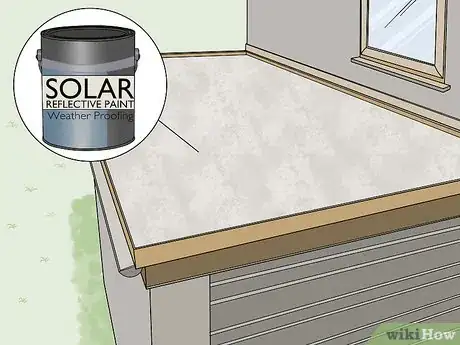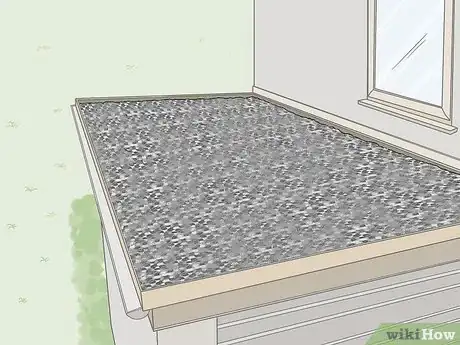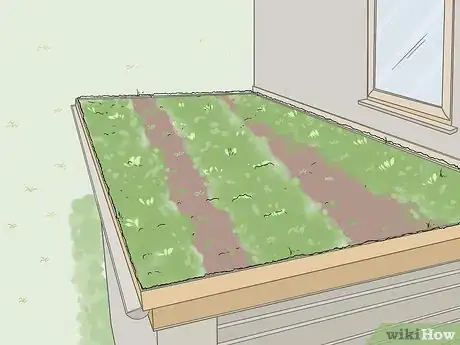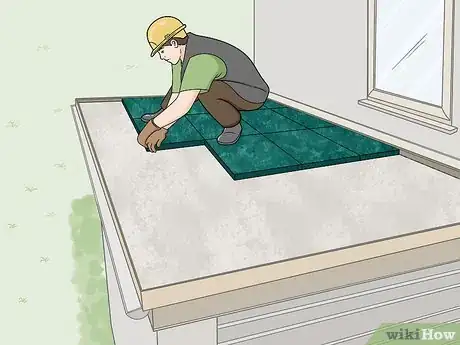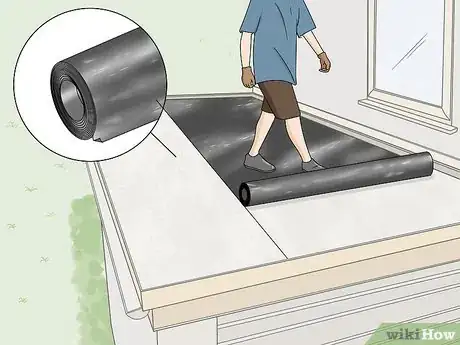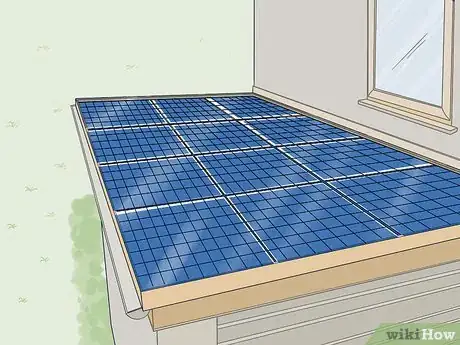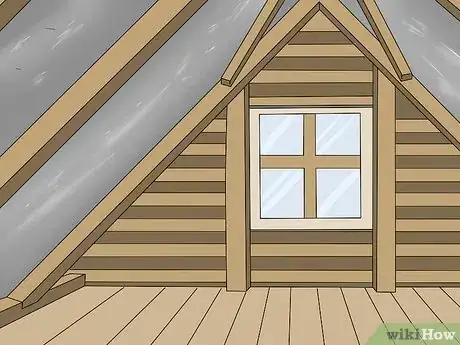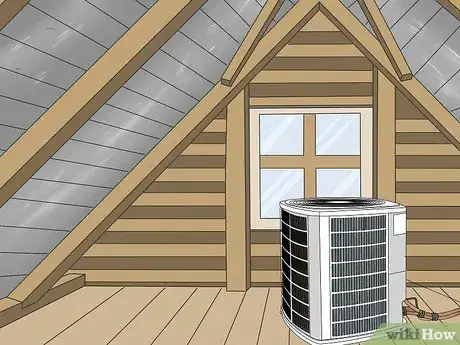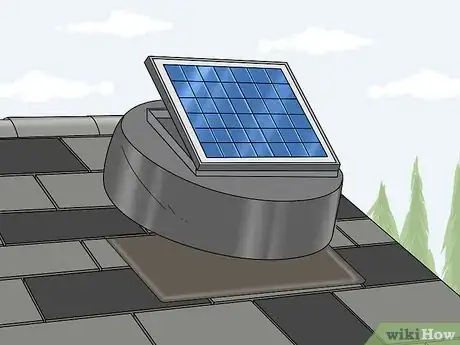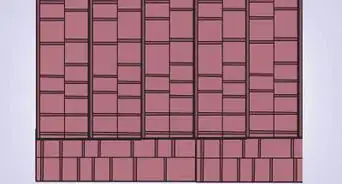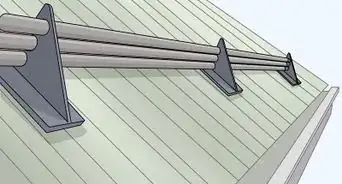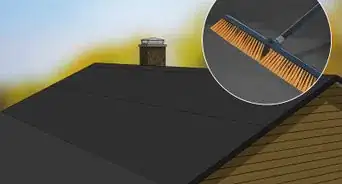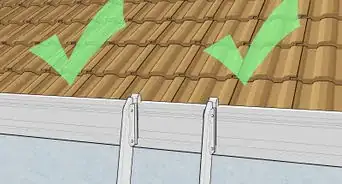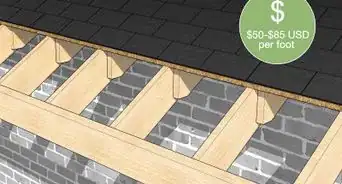This article was co-authored by Guy Gabay and by wikiHow staff writer, Eric McClure. Guy Gabay is a Solar Energy Contractor and the CEO of AmeriGreen Builders, a full-service solar energy, roofing, HVAC and window installation company based in the greater Los Angeles, California region. With over eight years of experience in the construction industry, Guy leads the AmeriGreen team focusing on bringing an educational approach to energy efficient home upgrades. Guy holds a B.S. in Marketing from California State University - Northridge.
There are 8 references cited in this article, which can be found at the bottom of the page.
This article has been viewed 41,385 times.
There are a variety of ways to protect your roof from sunlight and heat. If you have a flat roof, the easiest way to avoid sun damage is to cover your home in a reflective coating. You can also pour gravel or plant a garden to cover your roof and protect it from direct sunlight. Alternatively, you can hire a contractor to spray polyurethane foam or install a membrane over your roof. In addition to modifying your roof, keeping your attic cool will help minimize the sun’s impact on your roof, especially in the summer. Install radiant barriers and increase ventilation in your attic to keep your roof cool and safe over an extended period of time.
Steps
Modifying Your Roof
-
1Cover a flat roof with reflective paint to keep the heat off. Cool roof coatings are white or silver paints that are made with reflective pigments. Cool roof coatings are the most commonly-used method to cool roofs because they’re inexpensive, easy to use, and don’t require help from a contractor. Purchase a cool roof coating in white or silver and paint your roof with a roller. Work your way from the edges towards the center of the roof to cover it in your coating.[1]
- In roofing, the term “cool roof” is used to denote a roof that is specifically designed to reflect heat.
- If your roof is made of shingles or asphalt sheeting, your roof is already designed to reflect heat and should not be painted. If you want to cover a metal roof, get a coating designed specifically for metal.
- Cool roof coatings are almost always waterproof as well.
Warning: If your roof sits on an angle, you cannot apply this coating. The coating essentially works like a mirror, and you could blind your neighbors and nearby motorists if your roof is visible from the ground. Painting a pitched roof is often illegal without a license as well.[2]
-
2Pour gravel on your flat roof if you want an added layer of protection. If you have a flat roof, you can add a layer of reflective gravel to protect the roof from sunlight while helping with drainage. Purchase reflective gravel from a roofing company or at a home repair store and take it up to your roof. Put on thick gloves and use a shovel to spread the gravel out along the surface of your roof. Add a 1–2 in (2.5–5.1 cm) layer across every surface of your roof and use the backside of your shovel to finish spreading it out.[3]
- You cannot add gravel to a roof that doesn’t have a rim around the exterior of the building. If there’s no barrier, your gravel will simply slide off of the roof over time.
Warning: Do not add massive heaps of gravel. They won’t be as effective as a clean, even layer. Large piles may also become hazardous over time as the weight weighs down your roof. Keep your layer of gravel thinner than 2 inches (5.1 cm) to avoid any structural problems.
Advertisement -
3Plant a garden on your roof if it’s flat and easily accessible. A rooftop garden is a great way to take advantage of the large amount of sunlight while blocking the surface of the roof from the sun. While you won’t be able to completely cover your roof, you will be able to protect a large majority of the surface. Get planter boxes, large pots, and storage boxes for your gardening materials. Set your garden up on the roof and visit it regularly to water and care for your plants.[4]
- Your roof must be structurally sound to handle the weight of a large garden. Contact an architectural or engineering firm to inspect your roof before installing a garden.
- Most roofs don’t have access to a running supply of water, so you may need to store water on the roof or run a hose up to the roof.
-
4Get a contractor to cover your roof with polyurethane foam if it's sloped. To waterproof your roof while protecting it from the sun, hire a contractor to install a polyurethane foam on top of your roofing material. The contractors will clean your roof and use an aerosol spray to seal your roof in polyurethane foam. As the foam settles, it will adhere to the roof’s material and keep water and heat out. If properly installed, polyurethane foam will last for 50 years.[5]
- It is illegal to install a polyurethane foam roofing membrane if you aren’t a licensed contractor. You must hire someone to install it for you.
- Polyurethane foam coatings cost $4-7 per square foot ($13-22 per square meter).
-
5Hire a contractor to install a reflective membrane if you have a sloped roof. Roof membranes are prefabricated sheets that are attached to a roof using fasteners. They reflect sunlight and keep weather from wearing down your roof over time. You cannot install a membrane yourself, so contact a contractor in your area to get quotes for a roofing membrane. Hire a contractor and give them 3-5 days to install the membrane.[6]
- This is the best option for sloped roofs that can’t be painted with a reflective coating. However, if you already have an asphalt or shingle roof, you may not see a ton of improvement.
- Roofing membranes typically cost $4-5 per square foot ($13-16 per square meter).
-
6Get solar panels installed to cool your roof and cut your utility costs. Solar panels are designed to attract sunlight in the area around them.[7] In addition, they physically cover a large portion of your roof, partially shielding it from exposure to the sun. This can lower the temperature of your roof considerably while saving you money at the same time. Buy solar panels if you can afford the upfront cost and want a long-term, sustainable solution to keep your roof cool.[8]
Tip: While it can cost $10,000-30,000 to initially install the solar panels, the prices come down every year as the technology improves. They also pay for themselves over a longer period of time as your electric and gas bills go down.[9]
Keeping Your Attic Cool
-
1Install radiant roof barriers to insulate your attic. While it won’t limit your roof’s contact with the sun, radiant roof barriers can keep heat off of your roof by limiting the space where the heat can go. Purchase a roll of radiant roof barrier from a supplier and spread it out along your wall. Staple the sheeting into your joists or studs, spreading it out with your hands as you apply it. This won’t actually protect your roof directly, but it will help keep the heat from building up in your roof.[10]
- Radiant roof barriers are typically installed in an unfinished attic where there isn’t much interior insulation.
- Use a utility knife to cut slits into the sheeting to wrap it around any pipes or columns.
- The barrier doesn’t need to be taut or airtight to work effectively. So long as the majority of your attic’s walls are covered, most of the heat from the sun will struggle to enter your home.
Tip: This can be kind of tricky to do without the help of friend holding the opposite end of a sheet up. Ask a friend or family member to stabilize the sheets for you as you staple.
-
2Put a fan or AC unit in your attic to improve ventilation. Keeping your attic properly ventilated is an excellent way to naturally lower the temperature of your roof. Install a ceiling fan or set up a large industrial fan in your attic. If you want to cool the attic independently of the rest of your house, install a window unit in a window in your attic.[11]
- Keep in mind that any of these options will cause your electricity bill to increase. However, your air conditioning costs will certainly go down in the summer.
-
3Install a solar-powered fan to force air through your roof’s vents. There are air gaps built near the floor where your pitched roof meets the floor. To increase the natural ventilation in your attic, get a solar-powered fan designed to push more air through the vent. Adhere the small solar cell to the edge of your roof or the side of your home and run the wire up to a vent in the middle of your attic. Then, orient the fan towards the vent to keep hot air pumping out of your home.[12]
- The benefit of a solar-powered fan is that it will only kick on when the sun is out.[13] This will naturally regulate the temperature in your attic.
- You can hire a contractor to install one of these fans for you.
Warnings
- If your roof isn’t flat, don’t risk getting up on your roof. It’s better to hire a contractor than risk your life to keep your roof cool.⧼thumbs_response⧽
Things You’ll Need
Modifying Your Existing Roof
- Reflective coating
- Roller
- Roller extension
- Screwdriver
- Reflective gravel
Installing New Materials
- Gardening tools
- Planter boxes
- Pots
Keeping Your Attic Cool
- Solar-powered fan
- Fan
- Air conditioning unit
- Shovel
- Radiant barrier sheeting
- Utility knife
- Gloves
- Staple gun
References
- ↑ https://www.energy.gov/energysaver/design/energy-efficient-home-design/cool-roofs
- ↑ https://www.theguardian.com/sustainable-business/2017/apr/13/cool-roofs-beating-the-midday-sun-with-a-slap-of-white-paint
- ↑ https://www.energy.gov/energysaver/design/energy-efficient-home-design/cool-roofs
- ↑ https://www.energy.gov/energysaver/design/energy-efficient-home-design/cool-roofs
- ↑ https://www.energy.gov/energysaver/design/energy-efficient-home-design/cool-roofs
- ↑ https://www.energy.gov/energysaver/design/energy-efficient-home-design/cool-roofs
- ↑ Guy Gabay. Solar Energy Contractor. Expert Interview. 4 August 2020.
- ↑ https://phys.org/news/2011-07-solar-panels-cool.html
- ↑ http://news.mit.edu/2018/explaining-dropping-solar-cost-1120
- ↑ https://youtu.be/d-ShAiclBt4?t=23
- ↑ https://www.energystar.gov/campaign/seal_insulate/do_it_yourself_guide/about_attic_ventilation
- ↑ https://www.latimes.com/archives/la-xpm-2001-sep-02-re-41189-story.html
- ↑ Guy Gabay. Solar Energy Contractor. Expert Interview. 4 August 2020.
